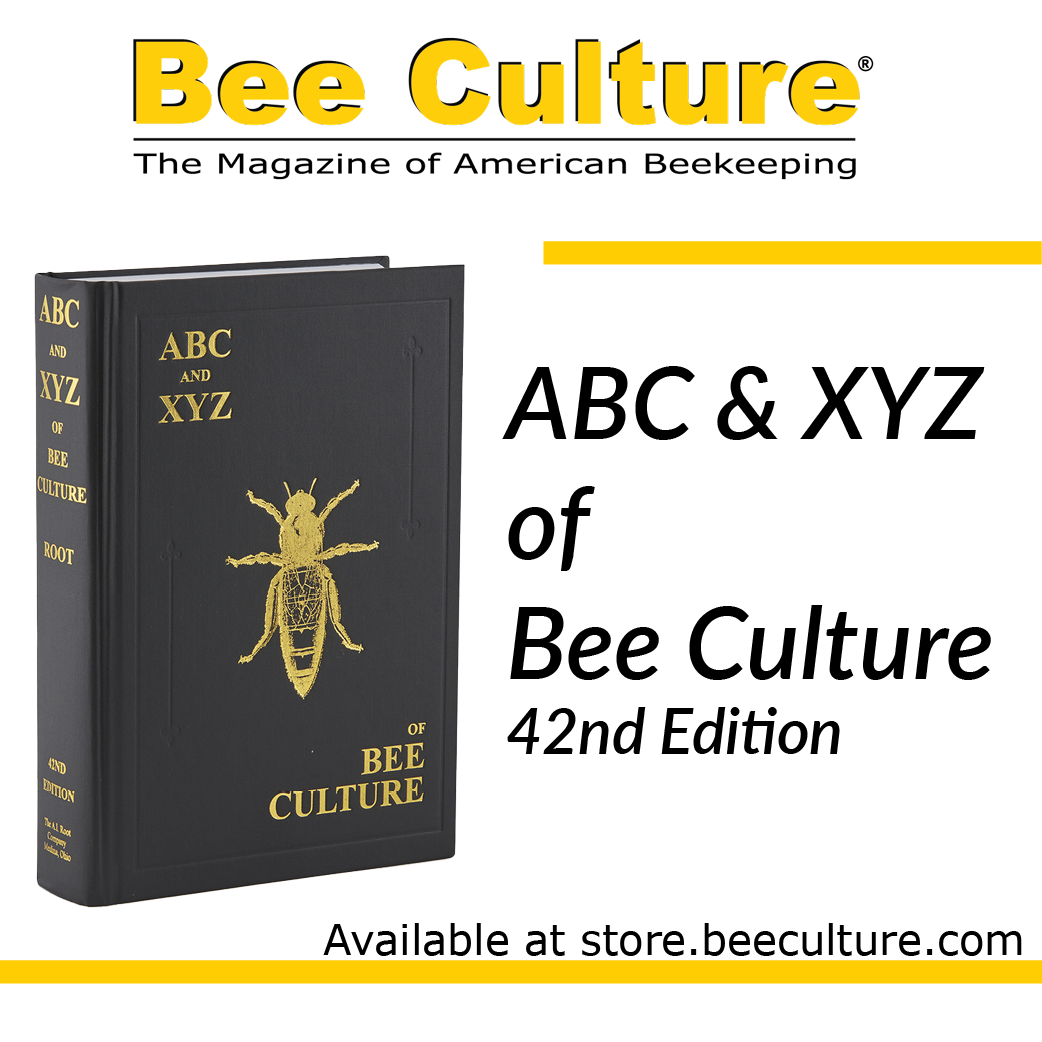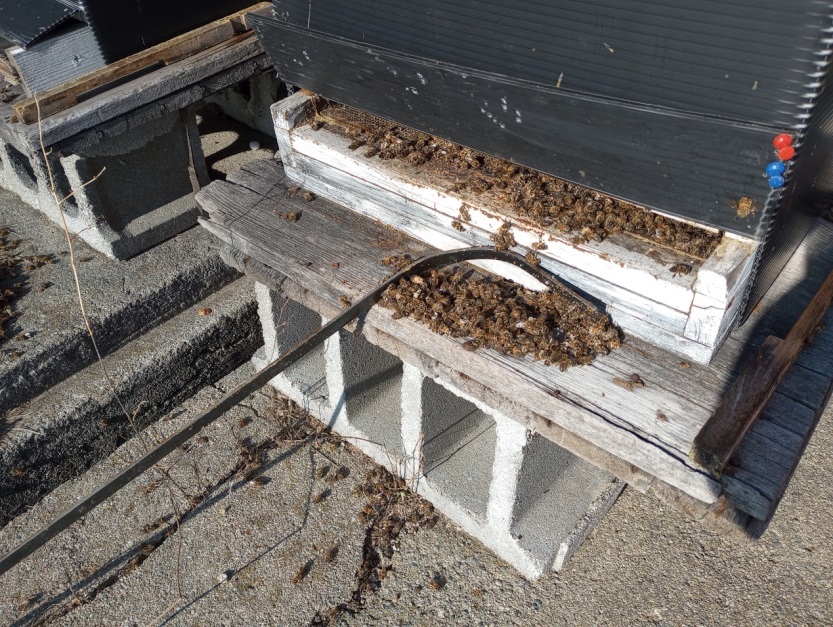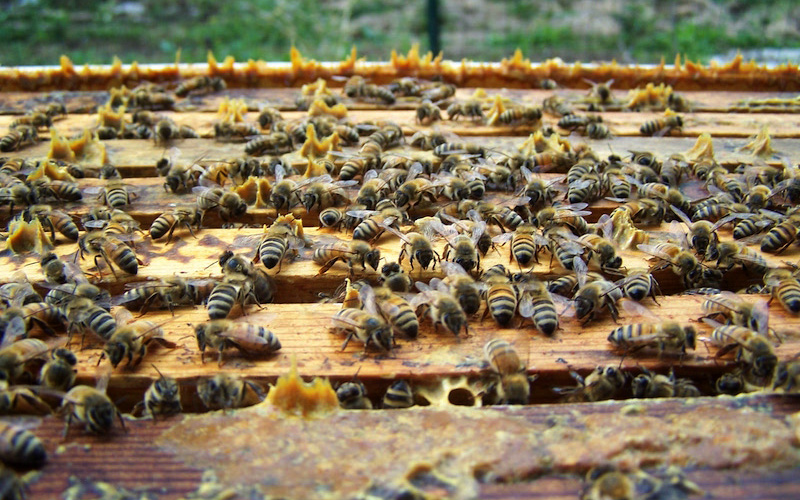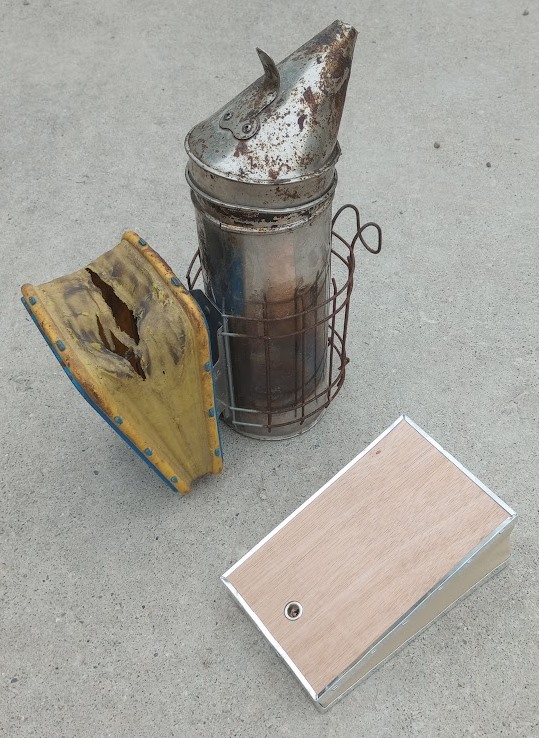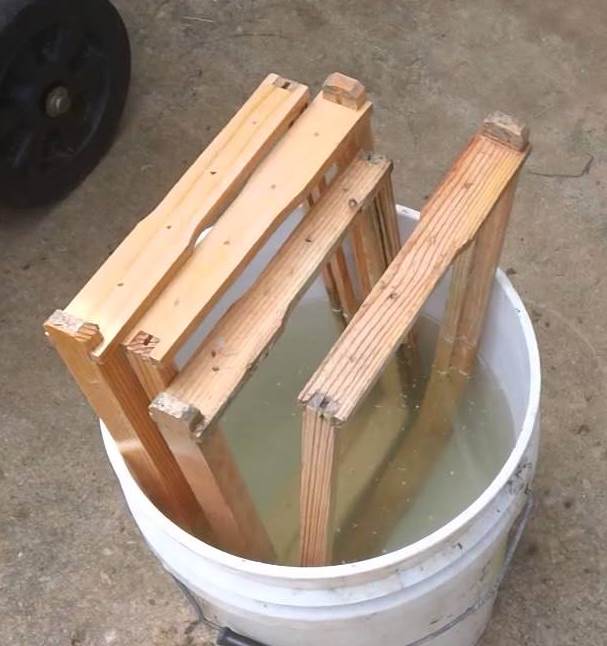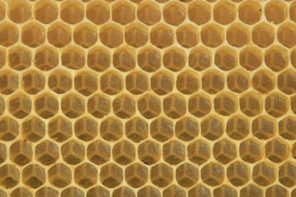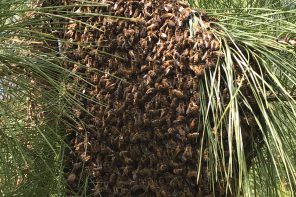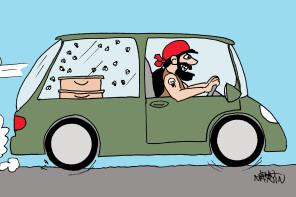Click Here if you listened. We’d love to know what you think. There is even a spot for feedback!
Read along below!
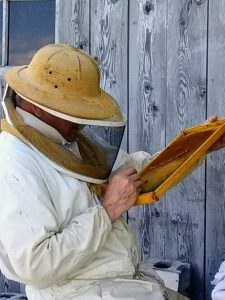
Richard Wahl began learning beekeeping the hard way starting in 2010 with no mentor or club association and a swarm catch. He is now a self-sustainable hobby beekeeper since 2018, writing articles, giving lectures and teaching beginning honey bee husbandry and hive management.
Off the Wahl Beekeeping
New(ish) Beekeeper Column
Winter Fit It Tips
By: Richard Wahl
Winter Doldrums
Winter is a time when active interaction with our bees really slows down or even comes to a complete halt. Other than popping the outer lid open to check to see if your candy board, fondant, sugar brick or mountain camp supplemental supply of granulated sugar is getting used up, there is not much that can be done for the bees during Winter. If the bees are going through any of the aforementioned supplements listed too fast it may mean too much honey was taken from the hive in the Fall. Make note of this and try to leave more honey for the bees next year. A good way to check on the weight of the hive going into Winter is to use a suitcase scale. The hook on most bottom ends of suitcase scales can be modified into an “L” shape or replaced with an “L” bracket to lift one side of the hive. Lifting the second side and adding the two weights together will give a close approximation of the weight of the hive. In our area of SE Michigan it is recommend to have 60 to 80 pounds of honey in the hive. Therefore with a single ten frame deep weighing around 35 pounds and a double deep weighing 70 to 80 pounds the total hive weight going into Winter should fall in the 90 to 150 pound range depending on the number of overwintering deeps.
There is one job that should be done every other month or so. On any sunny day use a shepherd’s crook and pull the dead bees off the bottom boards. If the temperatures are below freezing there is a strong possibility the bees are clustered above the bottom board and very few live bees will be pulled out of the hive. This will require the temporary removal of any entrance reducer or robbing screen if they are still in place. Ignoring this task may result in a build-up of dead bees on the bottom board. The dead bees may be a source of disease and will give off moisture in the hive. Earlier in my beekeeping days I had so much dead bee buildup that it precluded bees coming and going from the bottom entrance. While most hives carried the dead outside and had very clean bottom boards in the Spring, one particular hive failed to keep up with the dead bodies and perished, either due to moisture build-up or some disease the dead bodies were spreading.
Frames
Common practice states that used brood comb should be replaced every four to five years. As the comb ages and is reused the wax can acquire and hold pesticide residues detrimental to the bees. As bees move from their larva to pupa, known as the capped cell stage, a very thin encasement is present that reduces the size of the cell after every use. Research has found that after three to four years the size of the cell is reduced by as much as fifteen percent. This results in each bee raised in that cell having a minuscule smaller body weight at each subsequent emergence. The smaller the bee is the less the body mass and the less strength to retrieve pollen, nectar, water or resin for propolis. Over time bees will not use the smallest cells for anything other than storing pollen or nectar and if near all the frames have old comb they may even decide to abscond from the hive. It is often hard to track how long a frame of drawn comb has been used. Some beekeepers write the last number of the year on each frame when first used. I find an easy method is to move new frames to the center of the super and other frames outward when the first Spring inspection occurs. Each Spring two or three of the outermost frames are removed with new frames added near the middle. Any frames that have been removed can be cleaned and rewired if using wax foundation, or if using plasticell foundation, old comb can be scraped off and the frames reused. Although this cleaning process is easier on a warm sunny day it can still be done during the Winter. Scraping old comb off frames in the Winter may require a pressure wash in the Spring to remove remnants of the comb that did not come off. I find a 1750 psi pressure washer works well for this. If there is pollen in the comb that needs to be removed, this can easily be done by soaking the frame in warm water for a day or two and then using a garden hose spray nozzle to wash the pollen out of the cells. I use a five gallon bucket and soak half the four or five frames I can get in the bucket for several days followed by a rotation to soak the other half. If the comb is still relatively new a gentler spray can be used and will do very little damage to the comb which can then be left to dry and reused.
Smokers
Smokers tend to get a build-up of creosote particularly if any type of wood chip or wood based product is used as a fuel source. The first step in cleaning a smoker is to scrape as much of the tar-like creosote off the smoker as possible. To get a smoker real clean it can be soaked in a mix of one cup white vinegar for each gallon of water in a small plastic tote available at most big box stores. If you can find the 30% cleaning vinegar, also usually sold in the big box stores, this mix works even better. A rag dipped in the vinegar/water solution can be used to rub most of the remaining creosote off the smoker. For obvious reasons you should not get the bellows wet as it will disintegrate much faster even if it is left to dry out after being wet. My first smoker had a plastic type baffle which eventually wore out after fourteen years of use. Separate baffles can be purchased and it is just a matter of removing the four screws holding the old baffle and replacing it with the new. I find a good fuel source for my smoker to be a layer of the small animal bedding wood chips in the bottom. I get a good flame started with a plumber’s utility torch that has the push button self-igniter. After I get a flame and embers going I wad the brown paper that often comes as packing in packages to fill the remainder of the smoker. As long as the wood chip embers are not snuffed out, the brown package packing paper will put out a nice white smoke for a considerable amount of time.
Supers
Winter is a good time to build any new supers that are intended for the following year’s use. It is also a good time to repaint any supers that have been removed from hives. Research has found that the bees’ preference of color is yellow, then purple and blue in that order. Although it is normal to see most hives painted in white I feel alternating colors help the bees find their way back to their own hive and that it reduces the potential for drift. I find this to be especially true after doing splits where virgin queens that go out to mate need to find their way back to their home nucleus hive (nuc). Water based paint is recommended for supers. Even though only the outside of supers is painted, oil or lacquer based paint may give off fumes long after the paint is applied, so why take the chance? If frames or supers have gotten moldy they can be soaked in a ten percent bleach to water solution for thirty minutes to an hour which will bring the unpainted wood back to looking near new. Be sure to remove comb or plasticell foundation before soaking frames.
There is also a philosophy among beekeepers that scraping the inner walls of a super provides more area for the bees to store propolis. Since propolis is the bee’s natural disinfectant there may be some merit to this. I have not done this step as the bees seem to fill all the spaces, particularly around the frame rests, with plenty of propolis. For any hive supers that have had honey frames removed it is a good idea to scrape the propolis off of the super’s top frame rest groove to make it easier to replace frames. Honey frames may also need to have propolis scraped off the ends to make them sit better on the super frame rest.
Cleaning Tools
I find the best way to clean tools and straining screens is boiling water. For the straining screens I bring a pot of water to a boil and then hold one portion of the screen over a five gallon bucket with long handled pliers. Pouring very hot water over the bottom portion of the screen clears most of the collected wax and propolis. A second pot of boiling water is usually enough to get the second straining screen cleaned. I also line my de-capping collection tray with two layers of grade 60 cheesecloth. This works equally as well as the straining screens. When left overnight, honey from the cappings will drain into the bottom catch container and is then ready to be bottled. The wax cappings can be removed from the cheesecloth and placed in a separate container that will later be melted for wax extraction. If the cheesecloth is dipped in a five gallon bucket with several inches of boiling water several times most of the remnant wax will get pulled off and the cheesecloth can be reused several times. Other metal hive tools swirled in the bucket of very hot water will get most wax and some propolis removed. Once the propolis has been softened a mix of 50% isopropyl alcohol with 50% water on a cloth rag will rub most of the remaining propolis clean. Do not place propolis cleaning rags in a washer or dryer as the heat of the washer or dryer will cause the propolis to migrate to other pieces of clothing or unto inner portions of the washer or dryer. A blow torch could be used on metal hive tools which are placed on a cement surface, heated and the wiped clean, but beware of touching the hot tools if using this method. Do not use a torch on straining screens as it will cause them to rust at a later date. Keeping hive tools cleaned is also a good way to avoid the passing of any diseases from one apiary or hive to another.
Washing Bee Suits and Gloves
Washing a bee suit is not needed after every use. Any washing instructions that are provided with the suit should be followed per manufacturer recommendations. I find that a wash once a year is sufficient enough to hide any sting pheromone that may remain if any stinger appendages got unto the suit. No one but the bees or another beekeeper will see a dirty suit. Using a light detergent and mild wash cycle will be the gentlest way to clean a suit. Suits should be hung out to air dry to avoid shrinkage. If a detergent is used, a thorough rinse cycle should be employed so that any detergent odor does not upset the bees. As far as gloves go, rubbing them with a wet cloth with a 50% alcohol to water ratio is usually the best choice. When put through a wash cycle, most leathered gloves will tend to shrink to an extent that they may not fit well for subsequent use. It is best to wash gloves while wearing them much as you would wash your hands. If a leather conditioner is applied to the gloves before use, this seems to make the gloves last longer. If a beekeeping veil needs cleaning, it is usually enough to give it a rinse in plain water. After doing this a light spritz or rub with common cooking almond extract across the front of the veil seems to deter the bees from attacking the veil near the face.
Storing Unused Supers
After extracting honey from supers I like to place them over the inner cover and below the outer cover for the bees to clean out. In this manner only the hive bees can get to the honey super. The later in the year this is done the more likely the bees will not begin storing honey in to be cleaned out supers. If they do begin storing honey in a super that is meant to be cleaned, it may mean the bees need more super frame space or the outer most empty frames in supers need to be moved nearer the center of the super to encourage bees to fill them first. Once the cleaned supers are removed from the hive I like to clean the excess propolis off the frame rest and off the ends of frames to make them fit better upon reuse. Following this cleaning I cycle frames through an old chest freezer for two days to kill off any hive beetle or wax larva eggs. Then they can be stacked using Para Moth crystals on a paper plate over every fourth or fifth super. I like to place them in a black plastic garbage bag for storage in an umheated out building until next Summer’s use. As long as there are no holes in the plastic bags, hive beetles or wax moths cannot get to the drawn comb frames in the super.
Finale
I am sure there are many alternate ways to do many of the things mentioned above. These are simply some of the techniques that I have adopted that have worked for me over my years as a beekeeper. Having clean tools and supers ready to throw on the hives in Spring and Summer makes the management of bees a much more enjoyable adventure when last minute cleaning or preparations have already been accomplished. Develop your own system of preparation when other active beekeeping slows in the Winter and you will not regret having things ready to go when you need them next season.

